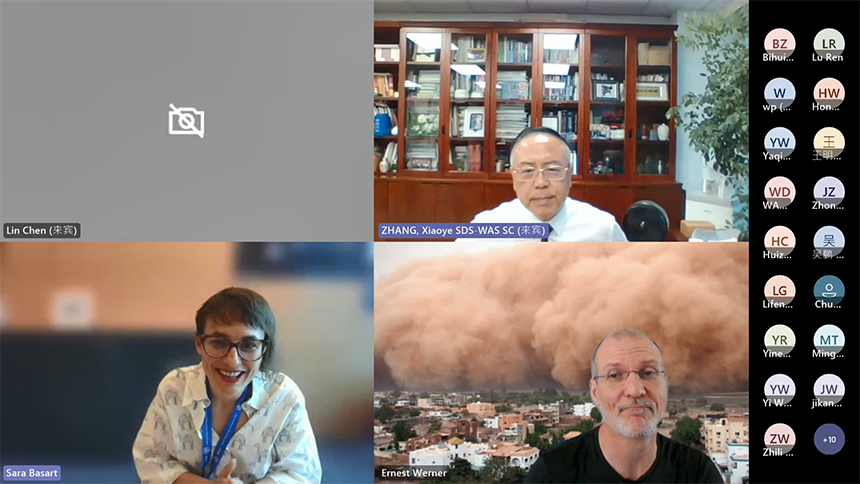REGIONAL SPECIALIZED METEOROLOGICAL CENTER (BEIJING) FOR ATMOSPHERIC SAND AND DUST STORM FORECASTING
(RSMC-ASDF BEIJING)
SAND AND DUST STORM WARNING ADVISORY AND ASSESSMENT SYSTEM ASIAN REGIONAL CENTER
(SDS-WAS ASIAN-RC)
On July 12, a webniar featuring Towards the Development of Sand and Dust Storms Forecast and Celebrating the First International Day of Combating Sand and Dust Storms was held by the Regional Specialized Meteorological Centre for Sand and Dust Storm Forecasting (Beijing) (RSMC-ASDF Beijing) of the World Meteorological Organization (WMO).
Academician ZHANG Xiaoye, Vice-Chairman of the Asian Regional Scientific Advisory Committee of the WMO Sand and Dust Storm Warning Advisory and Assessment System (SDS-WAS), chaired the meeting.
Experts exchanged ideas on applying artificial intelligence in sand and dust storms (SDS) forecasting, strengthening the acquisition of space-ground-air-based observation data, and deepening regional cooperation.
During the meeting, Mr. ZHANG Xiaoye introduced in detail the history and development of the WMO SDS-WAS Regional Centre for Asia and its role in the United Nations Alliance Against Sand and Dust Storms (UNASD), as well as the progresses made in forecasting SDS and international cooperation.
On behalf of RSMC-ASDF Beijing, Dr. ZHANG Bihui of the National Meteorological Centre (NMC) introduced the recent scientific progresses and service development.
Dr. Ernest Werner, on behalf of the WMO Regional Specialized Meteorological Centre for Sand and Dust Storm Forecasting (Barcelona), presented relevant forecasting products of SDS.
Ms. Sara Bassett, Scientific Officer of the WMO Secretariat, pointed out that in recent decades, SDS had become one of the most serious disasters in the world, with significant impacts on socio-economic development, the environment, and human health. The International Day of Combating Sand and Dust Storms is intended to enable scientists, relevant practitioners, and the public to work together to deal with the risks posed by SDS.
Daniel Tang, Chairman of the SDS-WAS Global Steering Committee, emphasized the importance to further deepen exchanges and cooperation among member countries of the SDS-WAS Regional Centre to enhance the monitoring and forecasting, and early warning capabilities for SDS.
The UN General Assembly, meeting in June this year, decided to designate July 12 as the International Day for Combating Dust and Sand Storms to be observed annually.
China's scientific research and operational work on SDS have made significant contributions to international research on SDS as well as forecasting and early warning operations, and contributed to the establishment of the International Day of Combating Sand and Dust Storms.
Chinese scientists have long served as members of the WMO Advisory Committee on Sand and Dust Storm Early Warning, and promoted the construction of an international coalition on sand and dust storms by other UN organizations. RSMC-ASDF Beijing is located at NMC and plays a crucial role in the forecasting and prevention of SDS disasters in Asia.


(Editor: WU Peng, XU Nenyu)